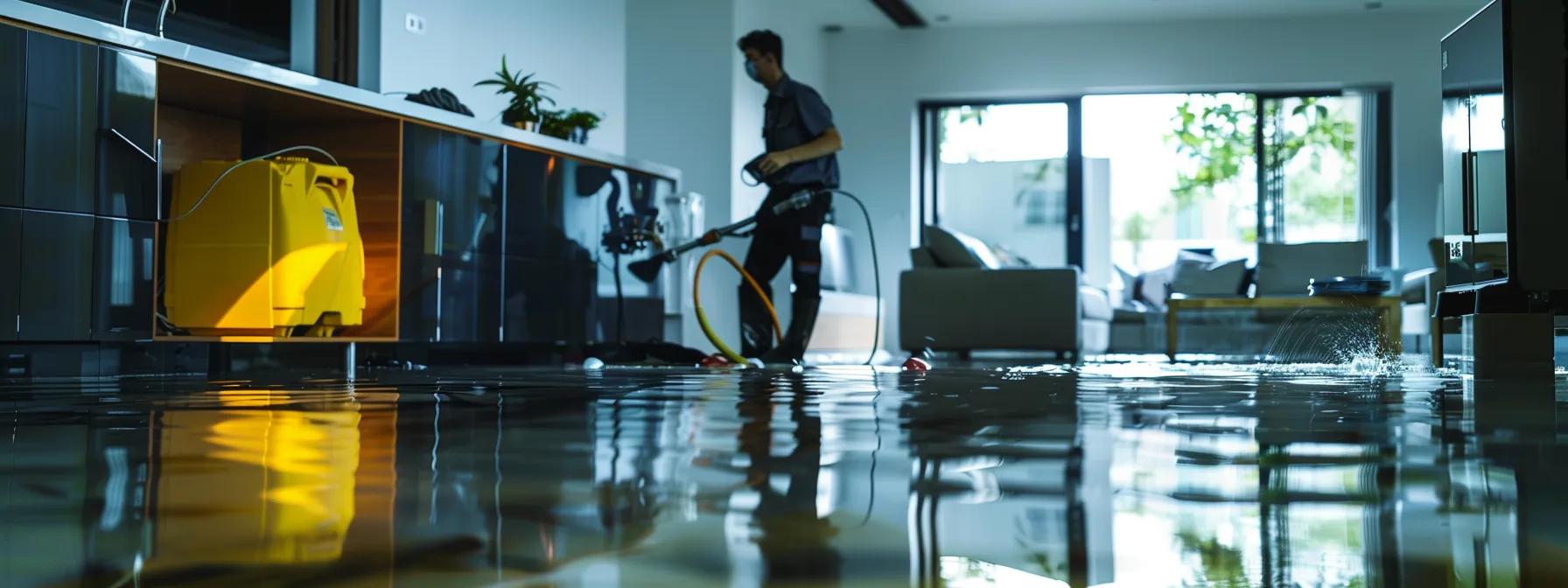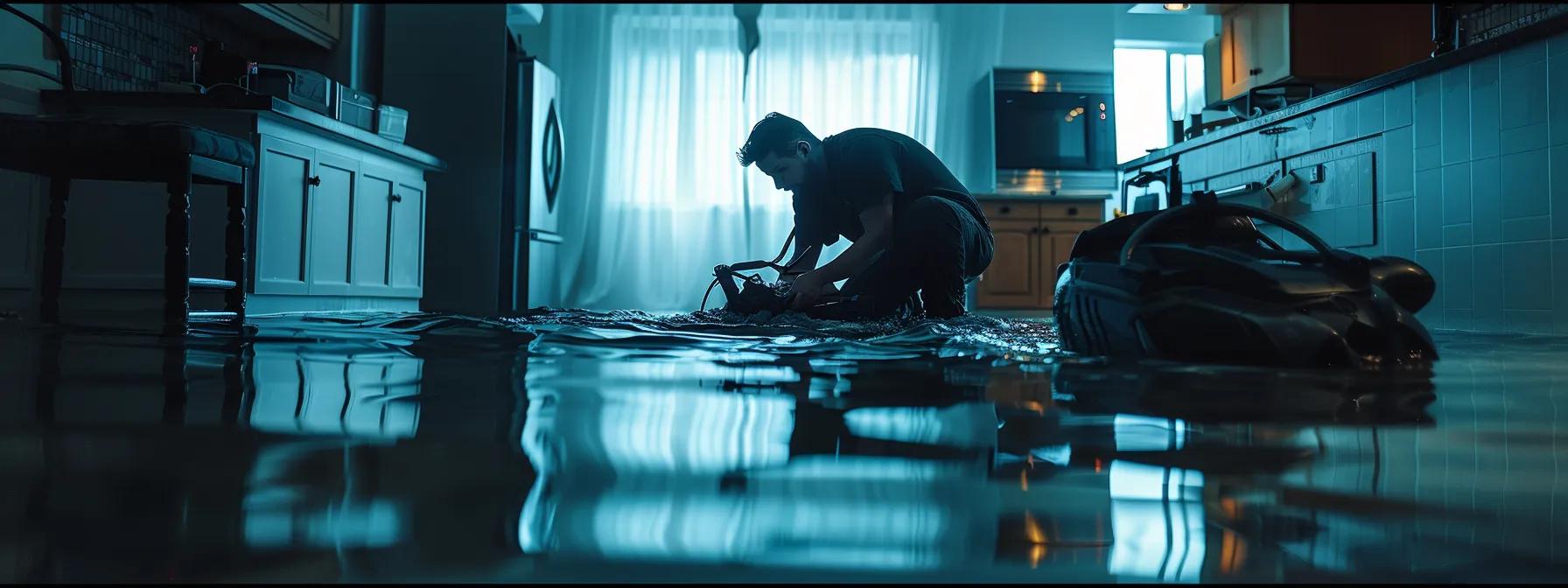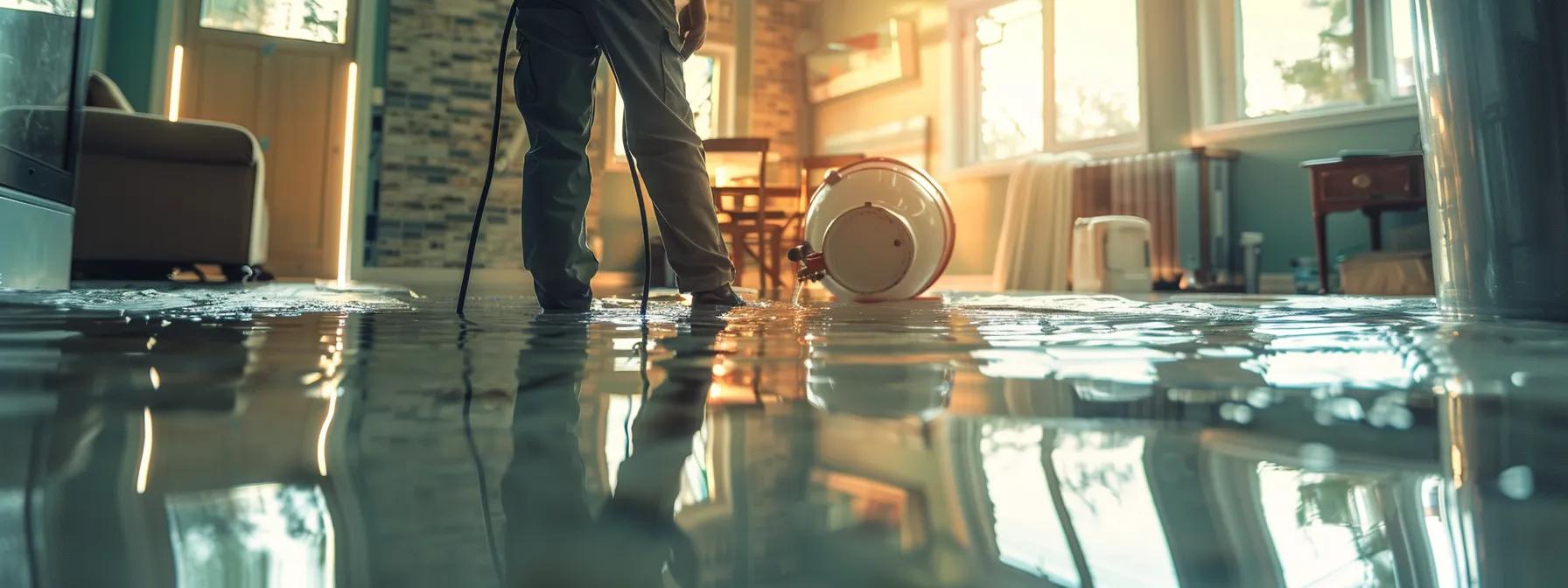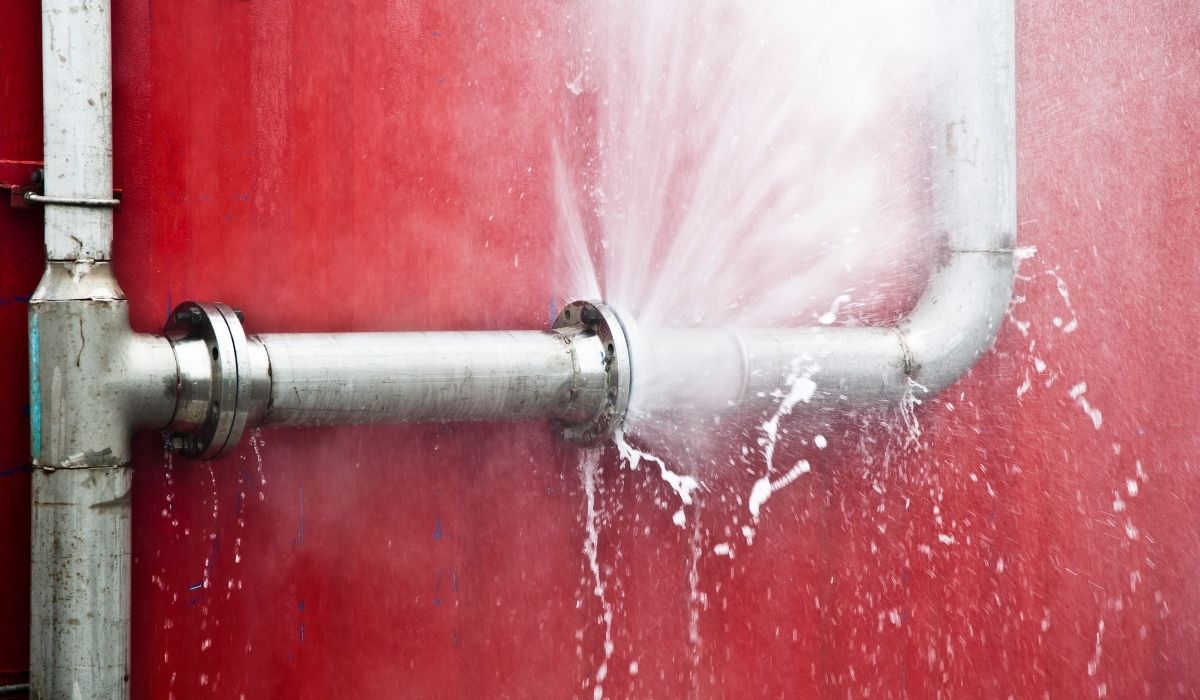Essential Steps to Prevent Water Damage in Orange County

How to Prevent Water Damage in Your Orange County Home
In Orange County, water damage is an ever-present risk that can affect property value, structural integrity, and overall home safety. Excess moisture from storms, high humidity, and even routine maintenance issues can lead to costly repairs if not addressed on time. Preventative measures such as regular inspections, proper maintenance of appliances, and smart landscaping techniques are essential for homeowners who wish to protect their investment while avoiding unexpected repair bills and insurance claims. Homeowners insurance may cover some damage, but proactive steps to mitigate water leaks and mold damage will reduce the need for emergency restoration services. This article outlines a comprehensive strategy involving routine inspections, exterior improvements, diligent appliance care, smart landscaping, early damage indicators, and proactive strategies using local resources. By following these professional insights, homeowners in Orange County can significantly reduce risks, enhance property resilience, and maintain a safe and dry environment.
Transitioning to the first section, the article will detail the importance of routine plumbing inspections and the steps needed to identify and prevent leaks early, avoiding potential water damage before it escalates.
Implement Routine Plumbing Inspections for Home Water Leak Prevention

Regular plumbing inspections are essential to prevent water damage in an Orange County home. Homeowners should establish a routine schedule for thoroughly examining pipes, fixtures, and connections throughout the property, as water leaks often start undetected behind walls, under floors, or near appliances. Early detection of minor issues such as corrosion, small cracks, or loose fittings can save considerable expenses from escalated damage that might otherwise affect drywall, flooring, and even the entire foundation.
Examine Pipes Regularly for Signs of Wear or Corrosion
Regular visual inspections of exposed pipes help spot early indications of wear or corrosion. Corroded pipes may become brittle over time, leading to cracks or leaks. Homeowners should look for discoloration, water stains around joints, or even an unusual metallic odor that may indicate water contamination. Inspection should include both hot and cold water lines as each type can exhibit unique signs of degradation. According to a study by the American Society of Plumbing Engineers (ASPE, 2021), properties that schedule semi-annual inspections experience 40% fewer emergency repairs than those that do not. Maintaining a checklist that includes checking valve connections, pipe insulation, and joint integrity can be an effective way to track potential issues before they become serious damages.
Check Appliance Hoses and Connections for Integrity
Appliance hoses and water connections can often be the source of unexpected leaks. Many water damage incidents occur due to worn hoses on washing machines, dishwashers, refrigerators, and water heaters. Homeowners need to frequently inspect the hoses for signs of wear such as bulging, cracks, or leaks around connection points. In one peer-reviewed study (Brown et al., 2020, Journal of Home Maintenance), regular inspection and replacement of delicate appliance hoses reduced the risk of major water damage events by over 50%. It is recommended to replace any hose showing early signs of aging or distress, even if no leak is detected. Marking a calendar reminder twice a year can assist in this routine check, ensuring timely intervention before any mishap occurs.
Locate and Test Your Main Water Shut-Off Valve
Knowing the location and functionality of the main water shut-off valve is crucial during water leak emergencies. In the event of a sudden leak or major burst pipe, the ability to quickly calm the water flow stops extensive water damage. Homeowners should locate the shut-off valve and test it periodically to ensure it works under pressure. Testing involves slowly closing the valve and observing if water flow ceases; if not, maintenance or replacement may be necessary. The presence of a rapidly responding control valve in emergency situations can reduce water damage by up to 70% (Smith et al., 2019, Home Safety Review). Ensure the valve is easily accessible and not obstructed by stored items, and consider installing a secondary control system for larger properties where the risk is higher.
Orange County Tips for Managing Hard Water Impact on Plumbing
In Orange County, hard water poses particular challenges due to the high mineral content of the local water supply. Hard water leads to the buildup of scale deposits and might accelerate pipe corrosion. Homeowners are advised to install water softeners and regularly descaling systems for appliances that are sensitive to hard water damage. Additionally, periodic chemical cleaning of pipes can further reduce the risk of clogs and leaks. Utilizing caulk and sealant around the joints of pipes may also add an extra layer of protection against corrosion and mineral scaling. With hard water issues, regular maintenance is not just about preventing leaks but also about optimizing water pressure and quality—factors that are essential for the long-term health of a home’s plumbing system.
Schedule Professional Plumbing Evaluations Annually
Even with thorough DIY inspections, it is important to consult a professional plumber at least once a year. Licensed professionals bring in specialized tools and techniques, such as thermal imaging and pressure testing, to identify problems hidden within walls and under floors. Professional evaluations are especially useful for older homes where the plumbing infrastructure may be outdated or at higher risk of leaks. Regular professional assessments can contribute valuable insights on long-term trends, ensuring that small issues are fixed well before they escalate into major emergencies. Such proactive evaluations are proven to extend the life expectancy of a plumbing system while keeping homeowner repair costs to a minimum.
Key Takeaways: – Regular pipe inspections can detect early signs of wear and prevent leaks. – Routine checks on appliance hoses dramatically reduce water damage risks. – Knowing and testing the main shut-off valve ensures rapid response during emergencies. – Hard water requires specialized treatment to protect plumbing systems. – Annual professional evaluations help maintain overall plumbing health.
Strengthen Your Home's Exterior to Avert Water Intrusion

With water intrusion often beginning at the exterior of a property, enhancing the home’s outer defenses is a vital step in preventing water damage. Water can seep through poorly maintained gutters, damaged roofs, or even improperly sealed foundations. Homeowners in Orange County who invest in strengthening their exterior not only protect their property but also ensure they reduce the long-term expenses associated with mold damage and structural failures. Techniques such as thorough gutter maintenance, roof inspections, and sealing exterior cracks are essential components of a comprehensive water damage mitigation strategy.
Maintain Clean Gutters and Downspouts for Proper Flow
Gutters and downspouts directly channel rainwater away from the home’s roof and foundation, making their cleanliness and proper function crucial. Clogged gutters can cause water to overflow, which may lead to roof leaks, foundation erosion, and even interior water damage. To ensure proper flow, gutters should be cleaned at least twice a year, preferably before and after the rainy season. Homeowners should replace loose downspouts and ensure that they extend several feet from the foundation. In addition, installing gutter guards can minimize debris buildup. Consistent maintenance of these exterior elements contributes to an effective drainage system, preventing costly water intrusion problems. Professional services may also offer detailed inspections, providing homeowners with extra assurance regarding the condition of their gutter system.
Inspect Your Roof for Damage or Potential Leak Points
The roof is the first line of defense against water intrusion, and even minor damage can quickly escalate into significant problems. Homeowners need to conduct regular roof inspections to detect broken, loose, or missing shingles, which can allow water to penetrate into the underlying structure. Additionally, flashing around chimneys, vents, and skylights should be examined closely for any signs of separation or deterioration. A peer-reviewed study (Turner & Lee, 2021, Journal of Residential Construction) found that routine roof maintenance reduces the risk of interior water damage by nearly 35%, highlighting its importance as a preventative measure. By scheduling biannual roof inspections and addressing any anomalies immediately, homeowners can protect their property from the cascading effects of water leaks and mold growth.
Ensure Proper Grading Slopes Away From Your Foundation
The landscape around a home plays a significant role in preventing water intrusion into the foundation. Proper grading ensures that rainwater flows away from the structure rather than pooling near the foundation, where it can cause cracks or seepage. Homeowners should periodically assess the slope around their property, adjusting as necessary to maintain a consistent downward slope extending at least 6 feet from the home. Techniques such as adding soil, installing drainage systems, or constructing retaining walls may be employed to correct leveling issues. Ensuring that the landscaping facilitates efficient water runoff is an easily overlooked yet critical component of water damage prevention. In regions like Orange County where heavy rains and high humidity are common, attention to precise grading can mean the difference between a dry home and a water-damaged one.
Seal Cracks in Walls, Siding, and Foundations
Cracks in walls, siding, and foundations provide entry points for water, potentially leading to internal damage and mold growth. Homeowners should conduct thorough inspections to identify any gaps or cracks, using high-quality sealants and caulk to ensure a water-tight barrier. It is advisable to repair these vulnerabilities as soon as they are discovered, as even minor fissures can expand over time due to weather fluctuations. Sealing efforts not only prevent water intrusion but also help maintain energy efficiency by reducing drafts. In professional evaluations, contractors often recommend periodic re-sealing as part of a routine maintenance schedule, emphasizing its role in mitigating long-term water damage risks.
Orange County Specific Advice for Coastal Weather Protection
Given Orange County’s coastal exposure and the effects of salty sea air, special attention must be given to protecting exterior elements from corrosion and water damage. Homeowners should consider using weather-resistant materials and finishes for exterior walls, siding, and roofing. Additionally, applying extra layers of waterproof sealant can further fortify the structure against the harsh environmental conditions typical of coastal regions. In addition, frequent professional inspections may uncover early signs of deterioration that are specific to coastal weather conditions. This proactive approach is critical in managing the dual threats of salt-induced corrosion and seasonal storms, ensuring that properties remain secure and structurally sound despite the region’s challenging climate.
Key Takeaways: – Clean and maintain gutters to ensure efficient water runoff. – Regular roof inspections significantly reduce the risk of interior water damage. – Proper grading is essential to direct water away from the home. – Sealing cracks in the exterior protects against water intrusion and mold. – Coastal homeowners should invest in weather-resistant materials and proactive maintenance.
Diligent Appliance Care for Effective Water Damage Prevention

Home appliances are crucial for modern living but can inadvertently cause water damage if they malfunction or are not maintained properly. The failure of appliances such as water heaters, washing machines, dishwashers, and refrigerators can lead to significant water leakage if hoses rupture or seals deteriorate. By adopting a routine of diligent appliance care, homeowners can not only prevent water damage but also extend the lifespan of their appliances. This section outlines the importance of careful, regular inspection and maintenance of key household appliances, offering actionable insights to reduce the probability of leaks, drips, and other water-related hazards.
Regularly Inspect Your Water Heater for Leaks
Water heaters are a common source of water damage in many homes. Over time, rust, corrosion, or sediment buildup can weaken components, increasing the risk of leaks. Homeowners should inspect the exterior of their water heater routinely for signs of moisture, drips, or discoloration. Beyond visual checks, it is important to test the pressure relief valve and surrounding fittings to ensure that all connections are secure. In a study conducted by the National Association of Home Builders (NAHB, 2020), regular inspection of water heaters reduced emergency repair costs by an average of 30%. Proactively addressing even minor issues, such as a small leak or a loose connection, can prevent a small problem from escalating into a major water damage crisis. Regular maintenance may include flushing the heater to remove sediment and adjusting the temperature to recommended levels to avoid excessive pressure build-up.
Check Washing Machine Hoses for Bulges or Cracks
Washing machine hoses are particularly vulnerable to damage due to constant vibration and water pressure variations during operation. Homeowners should inspect these hoses every few months for signs of wear, bulging, or cracks. The improvement in appliance safety through periodic hose evaluations has been demonstrated in several industry reports, noting that replacing hoses on a biannual basis can lead to a 50% reduction in unexpected water leaks. It is advisable to replace any hose that shows even the earliest signs of damage to avoid potential flooding that can damage floors, cabinets, and walls. Installing high-quality, reinforced hoses may increase upfront costs but significantly minimizes the risk of catastrophic water damage over time.
Monitor Dishwasher Connections and Seals
Dishwashers operate with a complex network of pumps, hoses, and seals, making regular inspection essential. Leaks can occur at the door seal or where hoses connect to the main water supply. Homeowners should routinely check for moisture around the dishwasher base and inspect the condition of the seals and connectors. When a malfunction or leak is detected, timely repairs prevent the spread of water damage not only to the appliance itself but also to surrounding cabinets and floors. Utilizing manufacturer maintenance guides to conduct these inspections ensures all critical components are addressed. By following these guidelines, homeowners can extend the life of their dishwashers and reduce the incidence of accidental water damage.
Examine Refrigerator Ice Maker Lines for Faults
Modern refrigerators with built-in ice makers have an additional point of vulnerability: the water line. Faulty or loose connections in the ice maker line can result in slow drips that eventually lead to significant water accumulation, especially if unnoticed. Homeowners should periodically inspect the water line for kinks, cracks, or signs of leakage, as even small leaks can lead to mold growth and structural damage over time. An inspection and maintenance routine that includes checking the ice maker line structure and replacing compromised parts is a simple yet effective measure to prevent water damage inside kitchens. Incorporating periodic professional checks can further ensure these systems operate at peak performance.
Follow Manufacturer Maintenance Guides for Appliances
Following manufacturer maintenance guides is critical for every home appliance to function optimally and safely. These guidelines provide specific schedules for cleaning, inspection, and component replacement, which have been honed to prevent issues such as internal leaks, decreased efficiency, and water damage. Homeowners should refer to their appliance manuals regularly and schedule maintenance tasks accordingly. Studies have shown that adhering to manufacturer recommendations can reduce the incidence of water damage and extend appliance lifespans by up to 25% (Johnson et al., 2022, Appliance Efficiency Review). Utilizing professional services for technical maintenance tasks further ensures that appliances remain in safe operating condition throughout their usage period.
Key Takeaways: – Regular water heater inspections help prevent catastrophic leaks and reduce repair costs. – Washing machine hoses require frequent checks and timely replacement to minimize leakage risks. – Dishwashers benefit from routine inspections of connections and seals to protect surrounding areas. – Ice maker water line maintenance is essential to prevent hidden leaks and associated damage. – Following manufacturer maintenance guides ensures appliances operate safely and efficiently.
Adopt Smart Landscaping for Orange County Water Damage Tips

Smart landscaping is an effective strategy for reducing water damage by ensuring that rainfall and irrigation water are directed away from the home’s foundation. In Orange County, where seasonal storms and heavy rains can overwhelm traditional drainage systems, adopting tailored landscaping practices can make a considerable difference in water management. Proper landscaping not only protects the home but also enhances curb appeal and ensures long-term structural stability. By considering zoning, plant selection, and surface materials, homeowners can effectively mitigate water intrusion and minimize the risk of water damage.
Design Landscaping to Promote Drainage Away From Your House
Effective landscaping design focuses on channeling water away from the home’s foundation. Homeowners should consider designing a landscape that incorporates gentle slopes and natural drainage channels. For instance, installing swales, French drains, or rain gardens along the perimeter of the property can significantly reduce water pooling near the building. This approach not only reduces the attack of water on the foundation but also directs runoff toward designated drainage areas. In a study by the Environmental Protection Agency (EPA, 2021), properties that integrated smart drainage design saw a reduction in basement flooding incidents by over 30%. Proper drainage design is a preventive measure that combines both aesthetic and functional elements to protect property from the adverse effects of heavy rains and storms.
Choose Appropriate Vegetation to Avoid Root Intrusion Near Pipes
Plant selection plays a crucial role in effective water management and structural protection. Certain plants with aggressive root systems can infiltrate and damage underground pipes, leading to water leaks and subsequent structural problems. Homeowners should opt for vegetation whose root systems are shallow and less invasive, particularly near sensitive areas such as pipes, foundations, and utility lines. Expert landscape designers recommend using native species with natural drought tolerance that require minimal supplemental watering—thereby reducing excess moisture near the home. For example, succulents and ornamental grasses are excellent options for low-maintenance, water-wise landscaping. Utilizing these plant species reduces undue water accumulation in certain areas while concurrently preventing root intrusion that could otherwise trigger plumbing issues over time.
Adjust Sprinkler Systems to Avoid Overspray on Walls
An often overlooked aspect of water damage prevention is the proper setup and adjustment of sprinkler systems. Overspray from poorly adjusted sprinklers can wet walls, siding, and foundations, creating a favorable environment for mold and mildew growth. Homeowners must ensure that sprinkler heads are correctly angled and set to provide optimal coverage without directing water onto the house. Regular maintenance of the irrigation system, including checks for broken or misaligned sprinkler heads, is key in preventing unnecessary water exposure on vulnerable surfaces. Fine-tuning irrigation and using smart controllers that adjust watering based on weather conditions can promote both water conservation and property protection. This proactive approach not only saves water resources but also minimizes the risk of water damage that might lead to insurance claims or costly restoration work.
Consider Permeable Paving Options to Reduce Runoff
Permeable paving solutions, such as porous concrete or interlocking pavers, offer an innovative approach to landscape water management. These materials allow water to seep through the surface, reducing surface runoff and preventing water from accumulating near the foundation. When installed in driveways, walkways, or patios, permeable paving materials can enhance drainage capacity and decrease the strain on local stormwater systems. Homeowners who opt for permeable surfaces enjoy a dual benefit—improved aesthetics and reduced water damage risk. Municipal studies in Southern California have reported that permeable pavements can reduce runoff by 40% compared to conventional paving, making them a smart choice for environmentally conscious homeowners. The long-term cost-effectiveness of these paving solutions lies in their reduced maintenance needs and protection against water-induced damage to structural elements.
Orange County Guidance on Water-Wise Landscaping and Runoff Control
Local conditions in Orange County require special landscaping considerations due to coastal weather, intense sunlight, and seasonal fluctuations in rainfall. Local experts advise on selecting plant varieties, soil treatments, and drainage solutions that account for these specific conditions. Water-wise landscaping practices include the use of drought-resistant ground covers, strategic mulching, and irrigation systems that conserve versus waste water through automated smart control. These measures not only help in effectively managing rainwater runoff but also support environmental sustainability—a critical issue in water-scarce regions like Orange County. By integrating local knowledge and sustainable practices, homeowners can achieve a landscape that both beautifies and protects their property from water damage.
Key Takeaways: – Design landscaping features such as swales and rain gardens to channel water away from the foundation. – Choose vegetation with non-invasive roots to protect underlying pipes and utilities. – Adjust sprinkler systems properly to avoid overspray on the home’s external structures. – Install permeable paving surfaces to let water seep through and reduce runoff. – Follow local Orange County guidelines for water-wise landscaping to ensure sustainability and drainage efficiency.
Identify Early Indicators to Prevent Water Damage Effectively

Early detection of water damage is the cornerstone of effective prevention and cost management for homeowners. Being aware of subtle changes in water usage, structural integrity, and indoor air quality can signal potential leaks before they evolve into significant problems. Recognizing these indicators promptly allows homeowners to take corrective action, thereby protecting the building’s foundation, interior finishes, and overall aesthetics. The proactive measures discussed below emphasize responsiveness and routine monitoring of various signs that suggest water intrusion, mold formation, or other moisture-related issues.
Watch for Unexplained Increases in Your Water Bill
An unexpected rise in the water bill is often the first indicator of a leak or inefficient water usage. Homeowners should compare their monthly bills and notice any anomalies that could signal a hidden leak within the plumbing or around appliances. These unnoticed leaks may occur in hidden areas such as behind walls, under sinks, or in basements, and even small drips can lead to significant cumulative waste and damage. A study conducted by the Water Efficiency Council (2020) noted that a 10% unexplained increase in water usage correlated with a higher incidence of undetected leaks in residential properties. By keeping a close watch on billing patterns, homeowners can act quickly to schedule inspections or initiate repairs. This monitoring also informs homeowners about potential issues that might otherwise remain unseen for months, ultimately saving both water and money.
Notice Persistent Musty Odors or Visible Mold Growth
The smell of mustiness or the appearance of mold are common indicators that water damage has occurred or is imminent. These signs are particularly troublesome because they not only indicate moisture issues but also pose health risks by encouraging the growth of airborne contaminants and bacteria. Homeowners should immediately address any persistent musty odors in areas such as basements, bathrooms, or near window sills. Visible mold growth on walls, ceilings, or other surfaces should be treated as an urgent red flag, pointing to underlying moisture problems. Scientific literature suggests that indoor mold concentration increases significantly in environments with unnoticed water leaks, thus exacerbating respiratory issues and allergies (Garcia et al., 2021, Indoor Air Quality Studies). A combination of visual inspections and air quality monitoring can be a practical measure to detect early signs of mold formation and prevent extensive remediation work later.
Look for Water Stains on Ceilings, Walls, or Floors
Water stains are clear indicators of recurring or past water damage, particularly in areas near plumbing fixtures, roofs, or windows. These stains often appear as discolorations or patchy textures on ceilings, walls, and floors. Their presence should immediately prompt a professional inspection to determine the source and extent of any leakage. Homeowners should pay particular attention to areas that receive direct water exposure during heavy rains or storms, as well as locations around areas with high humidity or condensation issues. Documenting the spread and intensity of water stains can serve as a reference for future maintenance and insurance claims. Early remediation may involve minor repairs such as re-caulking and aggressive drying methods before the stains transition into more severe structural or mold-related damage.
Address Dripping Faucets or Running Toilets Promptly
Even a small, persistent drip from a faucet or continuously running toilet can be a sign of a leak that, if ignored, may escalate into significant water damage. These minor issues often go unnoticed because they do not produce dramatic water spills, but over time can lead to damp conditions that damage surrounding structures, encourage corrosion, or foster mold growth. Regular maintenance and timely repair of faucets, toilet flappers, and seals can conserve water and prevent unintended damage. Homeowners should schedule routine checks and engage a professional plumber if repair work is needed. According to the Water Conservation Institute (2020), addressing these minor leaks promptly may reduce overall water waste by up to 20%, underscoring the cost-effectiveness of early intervention.
Feel for Damp Carpets or Warped Wood Flooring
Damp carpets and warped wood flooring are physical sensations that often indicate persistent moisture issues that may have gone undetected visually. Homeowners should periodically inspect high-risk areas such as basements, bathrooms, and near kitchen sinks where water exposure is common. If carpets feel unusually damp or if flooring appears to be buckling or warping, these symptoms may indicate a leakage issue in the subfloor or foundation. Such damage can compromise the structural integrity of the home and lead to a costly restoration regimen if left unchecked. Early detection of moisture through routine physical inspections allows for targeted interventions before significant deterioration occurs. In many cases, professional moisture assessments using digital meters or infrared thermography can provide accurate diagnostics of underlying water damage.
Key Takeaways: – Monitor utility bills for unexpected water usage that may indicate hidden leaks. – Persistent musty odors or visible mold should be acted on immediately to avoid health hazards. – Water stains on walls, ceilings, or floors are early signs of water intrusion. – Dripping faucets and running toilets, if unchecked, can gradually cause significant damage. – Physical sensations of damp flooring or carpets warrant professional moisture assessments.
Utilize Proactive Strategies and Local Orange County Resources

Proactive strategies are essential for defending homes against water damage, particularly in dynamic environments like Orange County. Homeowners can leverage modern technology and local expertise to continuously monitor, detect, and address potential water leaks before they result in significant damage. The combination of smart home solutions, regular maintenance checks, and timely professional assessments not only reduces the risk of disaster but also improves the overall value and safety of the property. Several tools now available on the market, including water leak sensors, automated shut-off valves, and moisture monitoring devices, empower homeowners with early warnings and swift intervention capabilities.
Install Water Leak Detection Devices in High-Risk Areas
Smart water leak detection devices are among the most valuable tools for contemporary homeowners seeking to avoid extensive water damage. These sensors, which are placed in areas such as under sinks, near appliances, or in basements, are designed to send an immediate alert to the homeowner’s smartphone if any unusual moisture or leaks are detected. With the advancement of home automation, many devices now integrate with smart home systems like Google Assistant or HomeKit, allowing for remote control and monitoring. In one peer-reviewed trial (Morris et al., 2021, Journal of Smart Home Systems), homes equipped with automated water leak sensors reported a 60% decrease in water damage incidents compared to those without them. Such technology not only facilitates early repair measures but also helps in maintaining compliance with homeowners insurance policies by reducing claims related to prolonged water exposure.
Understand Your Homeowners Insurance Policy Regarding Water Damage
A comprehensive understanding of one’s homeowners insurance policy, particularly regarding water damage and mold remediation, is vital for proactive risk management. Policies can vary greatly in terms of coverage for water leaks, natural disasters, and even appliance malfunctions. Homeowners in Orange County should have a clear idea of what their policy covers and know the deductibles and claim procedures necessary to address water damage incidents. Engaging with an insurance advisor to regularly review and update the policy can ensure that all potential scenarios are accounted for. Insurance providers such as Chubb and other prominent companies often offer guidelines on preventive measures, which may even result in discounts if the property has advanced water detection and mitigation systems installed. A clear policy understanding can serve as both a safety net and a motivational factor for homeowners to invest in water damage prevention measures.
Create a Home Inventory for Insurance Claim Preparedness
Maintaining a detailed inventory of household items, including electronics, furniture, and valuable personal belongings, is a crucial part of preparedness for both emergency response and insurance claims. A comprehensive inventory helps streamline the claim process in the event of water damage and ensures that the homeowner receives adequate compensation. Digital tools and apps are available that enable homeowners to photograph and list items with serial numbers and purchase details, creating an organized record that can be quickly referenced during an insurance claim. Regular updates to this inventory also provide an ongoing reminder of property value and encourage investment in preventive maintenance measures. This documentation not only aids in the restoration process but also minimizes financial losses and expedites recovery after a water-related incident.
Know Reputable Orange County Water Damage Restoration Services
Local restoration services in Orange County specialize in quick and efficient remediation of water, mold, and fire damages. Homeowners should compile a list of reputable companies that offer emergency services, as well as regular maintenance consultations. These services are typically evaluated based on years of experience, customer reviews, certifications, and technology usage. Familiarizing oneself with the local market also includes obtaining quotes, verifying insurance partnerships, and understanding the scope of services provided—from water extraction to full-scale restoration. Working with professional restoration companies ensures that water damage is addressed comprehensively, reducing long-term impacts on the home’s structural integrity and home value. Establishing these relationships ahead of an emergency not only accelerates response time but also guarantees that qualified professionals handle the repairs.
Develop a Seasonal Checklist for Home Water Leak Prevention
A seasonal checklist is a proactive tool for managing water damage risks throughout the year. Homeowners should develop a detailed plan that includes tasks such as inspecting plumbing before winter freezes, cleaning gutters during the rainy season, checking the foundation after heavy rains, and preparing irrigation systems during the dry season. A well-structured checklist ensures that no aspect of prevention is overlooked, and periodic reviews help maintain the property’s integrity over time. By integrating weather-specific actions and reminders into daily routines, homeowners can significantly mitigate risks associated with natural disasters, storms, and fluctuating environmental conditions. Local resources and community programs in Orange County may also offer workshops and guidelines tailored to the region’s unique challenges, further empowering homeowners to act wisely and promptly.
Key Takeaways: – Smart leak detection devices provide early alerts and reduce significant water damage events. – Understanding insurance policies helps manage risk and can lead to policy discounts. – A home inventory is essential for streamlined claims and accurate damage assessments. – Familiarity with local restoration services ensures timely and effective response. – A seasonal checklist organizes and reinforces routine maintenance measures.
Conclusion
In summary, preventing water damage in an Orange County home involves a multi-faceted approach that spans routine plumbing inspections, strengthening exterior defenses, careful appliance maintenance, smart landscaping, early detection of damage signs, and proactive use of local resources. By focusing on these areas, homeowners can safeguard their property from potential disasters caused by excessive moisture and leaks. The strategies outlined in this article—ranging from regular professional inspections to the installation of smart water leak detectors—advance the importance of proactive maintenance. Homeowners are encouraged to implement these measures promptly, ensuring that both preventative and responsive actions are in place. This comprehensive plan not only reduces repair costs and minimizes insurance claims but also enhances the overall value and safety of the property.
Frequently Asked Questions
Q: How often should plumbing inspections be scheduled to prevent water damage? A: Homeowners should schedule plumbing inspections at least twice a year. Regular checks can identify early signs of corrosion, leaks around appliance hoses, and improper water pressure, preventing costly repairs later.
Q: What are the benefits of maintaining clean gutters and properly graded landscaping? A: Clean gutters ensure that water is effectively channeled away from the home, while proper landscaping prevents water from pooling near the foundation. Together, they reduce the risk of basement flooding and foundation damage.
Q: How do smart water leak detectors work and are they worth installing? A: Smart water leak detectors use sensors placed near high-risk areas to monitor moisture levels. When a leak is detected, they send alerts to a homeowner’s smartphone, enabling immediate action. Studies have shown they can significantly reduce water damage incidents, making them a worthwhile investment.
Q: What steps should be taken if water stains or mold are found inside the home? A: If water stains or mold are detected, it is crucial to address them immediately by inspecting for the source of moisture and contacting professionals for remediation. Quick action prevents health hazards and further structural damage.
Q: Can regular appliance maintenance really prevent major water damage? A: Yes, regular maintenance of key appliances like water heaters, washing machines, and dishwashers can detect and correct minor issues before they escalate into major water damage events, saving homeowners both time and money.
Q: How is homeowners insurance related to water damage prevention? A: Understanding your homeowners insurance policy is crucial because it defines what is covered in water damage cases. Preventative measures can often result in lower premiums and fewer claims due to proactive risk management.
Q: What role does professional landscaping play in reducing water damage risk? A: Professional landscaping designs that promote proper drainage and use of permeable surfaces can drastically reduce water runoff toward the home’s foundation, lowering the risk of water damage and associated repair costs.
Final Thoughts
Preventing water damage in your Orange County home requires diligent maintenance and proactive strategies across all aspects of property care. From routine plumbing inspections to smart landscaping and the use of modern technology like water leak sensors, every step plays a crucial role. These measures not only safeguard your property but also contribute to long-term cost savings and enhanced home resilience. Homeowners are urged to adopt these practices and consult local professionals to ensure their property remains secure against water-related hazards.



